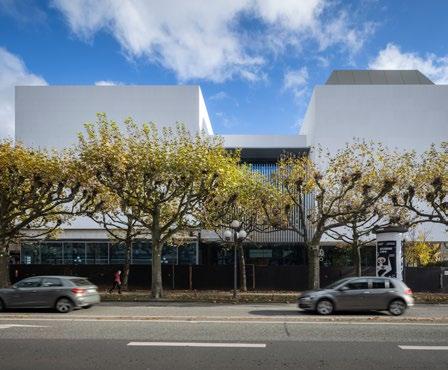
3 minute read
PRIVATELY COLLECTED –PUBLICLY PRESTENTED
Es heißt, er komme jeden Tag auf die Baustelle. Der Wiesbadener Unternehmer Reinhard Ernst sammelt abstrakte Kunst und hat der Landeshauptstadt ein Museum geschenkt. Mit allem Drum und Dran: die über vier Jahrzehnte gesammelten Kunstwerke, es sind viele Hunderte, allesamt wertvolle Sahnestückchen, der riesige Neubau an der Wilhelmstraße vom japanischen Stararchitekten Fumihiko Maki und der künftige Betrieb mit Kunstpädagogik, Museumsshop, Gastronomie, mietbaren Eventflächen und allem, was ein modernes Museum ausmacht. Alles wird komplett aus eigenen Mitteln mit Hilfe der gemeinnützigen Reinhard & Sonja Ernst-Stiftung finanziert. Für das Baugrundstück Wilhelmstraße 1, zuletzt ein Parkplatz am repräsentativen Boulevard, wurde mit der Stadt Wiesbaden ein Erbbaurechtsvertrag über 99 Jahre abgeschlossen. „Kein Euro Steuergeld ist in den Bau des Museums geflossen“, betont Direktor Oliver Kornhoff.
They say he comes to the construction site every day. Reinhard Ernst, an entrepreneur from Wiesbaden, collects abstract art and has donated a museum to the state capital. One with all the bells and whistles: the artworks collected over four decades – many hundreds of them, all valuable gems – the huge new building on Wilhelmstraße by Japanese star architect Fumihiko Maki and the future operation with art education, a museum store, eateries, event spaces for rent and everything else that makes up a modern museum. Everything will be financed entirely from the museum’s own funds with the aid of the non-profit Reinhard & Sonja Ernst Foundation. For the building site at Wilhelmstraße 1, most recently a parking lot on the prestigious boulevard, a 99-year ground lease agreement was signed with the city of Wiesbaden. “Not a euro of taxpayers’ money went into the building of the museum,” Director Oliver Kornhoff stresses.
Sugar Cube
„Zuckerwürfel“ nennen die Wiesbadener:innen den Neubau bereits. Tatsächlich begegnet der kubische Bau wegen seiner fast außerirdisch wirkenden, kristallin schimmernden Fassade aus amerikanischem „Bethel White“-Granit (insgesamt 6.000 Quadratmeter wurden verbaut) wie ein gigantischer Zuckerwürfel oder Monolith. Seine Traufhöhe entspricht jener der hübschen Gründerzeithäuser auf der gegenüberliegenden Seite der Wilhelmstraße – was, wie so vieles bei dieser Architektur und ihrer Verortung im Stadtraum, kein Zufall ist. Dann die zweite Überraschung: das Innere offenbart sich über die Stockwerke als eine Art begehbare Skulptur, die lichtvoller kaum sein könnte. Es ist ein Labyrinth, in dem man sich aber nicht verlaufen kann. Der höchste Raum ist gigantische 14 Meter hoch und entlockt uns ein Wort: „Kathedrale“. „Die Bezeichnung Zuckerwürfel finde ich gut. Das heißt, die Menschen setzen sich mit dem Bau auseinander“, freut sich Kornhoff.


The “Sugar Cube” is what Wiesbadeners are already calling the new building. In fact, the cubic building does looks like a gigantic sugar cube or monolith due to its almost extraterrestrial-looking, crystalline shimmering facade made of American “Bethel White” granite (a total of 6,000 m2 were used). The height of its eaves corresponds to that of the pretty Gründerzeit houses on the other side of Wilhelmstraße, which, like so much of this architecture and its location in the urban space, is no coincidence. Then the second surprise. The interior reveals itself over the floors as a kind of walkin sculpture that could hardly be more light and airy. It’s a maze, but one in which it’s impossible to get lost. The highest room is a gigantic 14 meters high and puts you in mind of a cathedral. “I like the term ‘sugar cube.’ It means people are engaging with the building,” Kornhoff enthuses.
Old Maple In The Atrium
Ein Stapler kreuzt unseren Weg, überall sind Handwerker beschäftigt. Über noch rohe Treppen geht es nach oben. Gerade wurden in einem Ausstellungsraum die Eichendielen geölt, es duftet schon von weitem. Bis zu fünf Meter lang sind die edlen Bretter. Anker und Orientierung ist, ganz gleich auf welchem Stockwerk man sich befindet, das verglaste „Atrium“, der Innenhof, der uns lenkt, anzieht und emotionalisiert. Wieder eine Überraschung: Unten im Hof wächst ein Ahornbaum. Ein 60-jähriger Koloss, der an diese Stelle verpflanzt wurde, was nur mit Hilfe eines Krans gelang. Neben dem Ahorn steht eine Stahlskulptur von Eduardo Chillida, einem der bedeutendsten Vertreter der abstrakten Plastik und bis zu seinem Tod ein Freund des Architekten Fumihiko Maki.
A forklift crosses our path; craftsmen are busy everywhere. The stairs are still crude. The oak floorboards have just been oiled in a showroom and you can smell them from afar. The ancient boards are up to five meters long. What anchors the place and helps you get your bearings, no matter which floor you’re on, is the glazed “atrium,” the inner courtyard, which guides and attracts us, rouses our emotions. Another surprise: a maple tree grows in the courtyard. The 60-yearold colossus was transplanted to this spot, which was only possible with the aid of a crane. Next to the maple is a steel sculpture by Eduardo Chillida, one of the most important representatives of abstract sculpture and a friend of architect Fumihiko Maki until his death.










